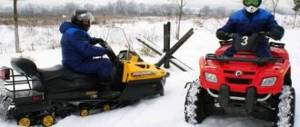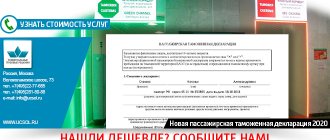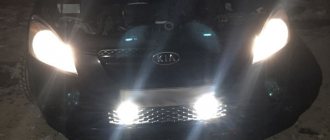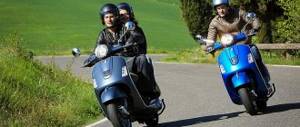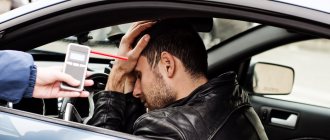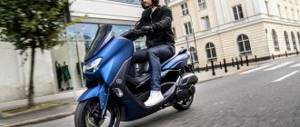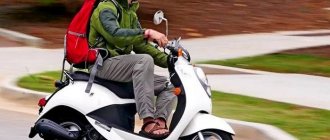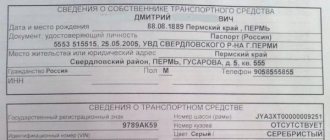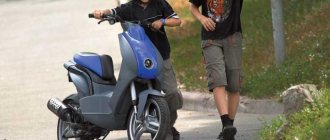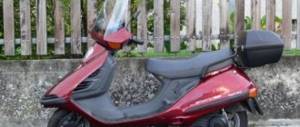The irresponsible attitude towards the Traffic Rules (hereinafter referred to as the Rules, SDA) of persons driving mopeds has become a real problem for the public, all participants in the road sector, as well as for the State Traffic Inspectorate service.
Dear readers! The article talks about typical ways to resolve legal issues, but each case is individual. If you want to find out how to solve your particular problem , contact a consultant:
+7 (499) 938-81-90 (Moscow)
+7 (812) 467-32-77 (Saint Petersburg)
8 (800) 301-79-36 (Regions)
APPLICATIONS AND CALLS ARE ACCEPTED 24/7 and 7 days a week.
It's fast and FREE !
Often, drivers of these types of vehicles (hereinafter referred to as vehicles) do not even bother to remember the signs and laws regarding driving a small vehicle.
There are separate paragraphs of the Rules specifically provided for such participants in road traffic in Russia.
Definition
A scooter and a moped are slightly different two-wheeled vehicles, but very similar in some ways. This is why these words are sometimes used as synonyms.
If all formalities are followed, it turns out that the term “scooter” does not appear in Russian legislation at all. It rather refers to the spoken language of the Russian-speaking population, using foreign borrowings.
In any case, all questions regarding how the drivers of these cars should behave on the roads are prescribed in the Rules. This means that all points relating to a moped also apply to scooters and their operation.
Regarding the question of whether a moped is a vehicle according to traffic regulations, it should be noted that yes, it is. And if so, then what category of vehicles do scooters and mopeds fall into?
Using justification to prove the existence of a category for a given type of transport - Art. 25 of the Russian legislative act “On Road Safety”, the category of mopeds is:
| M | engine volume not exceeding 50 cubic meters. cm |
| A1 | engine capacity no more than 125 cc. cm |
In the terminology of traffic regulations, a moped is a two-wheeled vehicle, recognized as mechanical, capable of reaching speeds of no higher than 50 km/h, and having an engine with a displacement of no more than 50 cubic meters. cm.
If the vehicle exceeds one or another of the parameters listed here, then it is a motorcycle, not a moped.
Mopeds can be equipped according to the production design (delivered from the factory) with an electric motor. Then its rated power should not exceed the longest load - more than 0.25 kW, and be less than 4 kW.
If ATVs have parameters similar to those of mopeds, then they are also equated to category M or A1.
Mechanical vehicle - what is it, trailers, towing and driving
A vehicle is a special device that is designed to transport goods and people over relatively long distances along roads.
Motor transport is usually classified according to different criteria, so many types can be distinguished. But the Traffic Rules use the following classification:
- Motor vehicles
- Non-motorized vehicles
Non-mechanical transport differs from mechanical transport in the absence of a motor that would set them in motion. In such devices, the motor is replaced by muscles or vehicles.
Non-mechanical ones include:
- Moped – driven by an engine;
- Trailer (towed) is a secondary component of the main vehicle;
- A bicycle is a vehicle that moves with the help of human efforts;
- A horse-drawn cart is a type of transport that begins to move with the physical efforts of the animal.
What is a motor vehicle (motor transport)
Motorized transport is by definition the opposite of non-motorized transport. The difference is that mechanical vehicles are driven by an engine. The type of engine does not matter, since it can be anything: gasoline and diesel, electric and gas.
The main condition: the purpose of vehicles is to move on roads.
The list of vehicles classified as mechanical is quite large. And based on the information that mechanical transport differs from all others in the presence of a motor, everyone may ask the question: “why is a moped not included in this list?”
The answer is simple: the structure of the moped does not allow it to be included in this list according to two criteria. The moped engine is less than 50 cubic centimeters and the speed does not exceed 50 kilometers per hour.
What then can be added to this list? Mechanical vehicles include cars and trucks, tractors, motorcycles and others.
In addition, vehicles are divided into categories.
Categories of motor vehicles
Cars can be divided into the following categories:
- Category A – motorcycles: -rollers, -cycles;
- Category B - a car with an established weight of no more than 3.5 tons. The number of permissible places is less than 8. It is allowed to use a trailer with a mass of no more than 750 kilograms. The trailer and vehicle must total 3.5 tons or less;
- Category C - a car with an installed weight of more than 3.5 tons. It is allowed to use a trailer with a weight of 750 kilograms;
- Category D – vehicles that are used to transport people over various distances. More than 8 seats are allowed in the cabin. Suitable for use with a trailer weighing 750 kilograms or less;
- BE - a car classified in category B; it is possible to operate a trailer weighing no more than 750 kilograms. The total weight of the entire train is above the permissible weight (3.5 tons);
- CE - a vehicle marked in category C, with a trailer exceeding the permissible weight;
- DE – a car classified as category D, the used trailer weighs more than the permissible limit (750 kilograms);
- F – trams;
- I – trolleybuses.
Where can I ride?
For mopeds, the DD Rules provide strictly for the following areas of the roadway:
- driving along the edge of the lane;
- driving on the side of the road;
- riding on a bicycle path, which is equipped at the edge of the roadway.
A bicycle lane sign under which mopeds and scooters are also allowed to ride.
You are allowed to ride a moped on the side of the road only if it does not interfere with pedestrians. A narrow strip on the roadway is allocated at the edge specifically for the passage of mopeds and scooters; it differs from the marking of the curb boundary.
It turns out that for this type of motorized transport it is only possible to travel in a row, one after another, if there are several mopeds moving along the highway.
The edge part of a highway or city road is allocated exclusively on the right side. Therefore, mopeds must drive strictly on the right side of the road.
However, it is not necessary to strictly observe the boundaries of such a line. In some cases, it is allowed for a moped to go around stopped public transport (buses, trolleybuses). But this is only possible in cases where the road is clear.
At what speed
The speed limit for mopeds involves driving at the maximum speed that this type of motor vehicle is generally capable of. But besides this, in those areas of the road infrastructure where the regime is set below the real capabilities of a scooter or moped, then the driver of a two-wheeled vehicle is required to yield to the rules that are regulated by road signs.
For example, in urban areas near schools, hospitals, kindergartens, parks, a “40” sign is often installed near the road. This suggests that you should drive here at a speed of 40 km/h, and not 50 km/h, as a moped can achieve.
Age limit for driving
The DD Rules themselves do not say anything about the minimum age limit for riding a moped. Since driving such a vehicle requires a license, then everything depends on obtaining it.
From the age of 16, you can already obtain a license for two categories related to driving motor vehicles:
| M | capacity up to 50 cubic meters cm |
| A1 | capacity up to 125 cu.m. cm |
Therefore, regardless of what category is assigned to the driver’s license in accordance with the type of vehicle, only persons who have reached the age of 16 have the right to study and obtain the right to drive a moped.
In practice, not only can you not ride a moped (or scooter) on the road if you are under 16 years old, but even enrolling in a driving school will be problematic.
Do you need a license for a 50cc moped?
It would seem that vehicles with an internal combustion engine displacement of less than 50 cm³ are characterized by low power, so there is no need to register them, and even more so to obtain a driving license for them. However, in practice it turned out that even with such modest indicators, drivers successfully create emergency situations, the reasons for which are often simple ignorance of traffic rules.
Obtaining a license for a scooter and moped is always accompanied by passing an exam on the theoretical part, which includes not only traffic rules, but also the provision of first aid. That's why legislators included scooters and mopeds with an engine capacity of up to 50 cubic meters in the list of vehicles that require a driver's license of a certain category to drive. In this case, this is the license for a scooter or moped of category “M”.
What documents should there be?
Since a moped is recognized as a vehicle belonging to the category of motorized transport, a license is required for it. The document must be carried with you while driving a moped, and also shown to a traffic police officer for verification upon request. This requirement is stated in clause 2.1.1 of the Rules.
Documentation for riding a moped:
- driver license;
- MTPL insurance;
- registration certificate.
Additional items that are not required to be carried:
- registration certificate;
- diagnostic inspection card.
A driver’s license can have two categories open, or one of two – M or A1. The most important thing is that it is not put in the “Special notes” column, category ML. It means that the mopedist has some health contraindications that do not allow him to drive this vehicle.
When according to traffic rules it is possible to cross a solid marking line, it is explained in the article: solid line in traffic rules. When traffic regulations require you to turn on your side lights, read here.
Basic traffic rules for mopeds and scooters
Since mopeds are also participants in road traffic, like other types of vehicles, they are subject to general traffic rules with some exceptions provided specifically for such lightweight motor vehicles:
| Point number in the traffic rules | Rule | Notes |
| 2.1.1 | Required to have a driver's license. | Obtaining category M or A1 is necessary. |
| 19.5 | Daytime headlights. | During the day, all cars participating in road traffic must turn on low-beam headlights or daytime running lights. There are no special headlights on the moped, so low beam headlights should be used. Switching on must be done immediately when the driver gets behind the wheel. |
| 24.7 | Driving along the right edge of the road lane. | A moped or scooter must move along the right edge of the road lane within the boundaries outlined by road markings (except for detours and other cases). |
| 22.21 | Carrying passengers on a moped (scooter). | Permitted only in cases where the driver has an open category A, or A1 for 2 years or longer. |
| 24.8 | Transportation of children | It is prohibited to transport children under 7 years of age on mopeds unless there is a special safe place for them. |
| Various prohibitions | It is strictly forbidden to: 1. Ride a moped and not hold the handlebars with your hands, even with one hand. 2. Carry cargo that exceeds the norm in size - 0.5 m in length, the width of the motor vehicle, or that interferes with the normal control of the machine. 3. Make turns on the tram track. 4. Make left turns on the roadway. 5. Turn left on roads with more than one lane. 6. Travel with a helmet on but not fastened. 7. Cross the path of pedestrians, moving along a zebra crossing designated specifically for pedestrians. It should be noted here that the driver of the moped can dismount from the vehicle and manually drive it along the pedestrian crossing. | |
| 24.9 | Towing | Mopeds cannot be towed. As well as towing them, too. They are only allowed to be transported with partial or full loading on a transport vehicle. The exception is mopeds with sidecars (trailers). |
Turning on the low-beam headlights allows other road users to recognize that a moped is driving ahead. The rule in paragraph 19.5 is written precisely so that participants can turn on the lights to signal that their car is somehow special, different from others.
For example, when transporting children during the day, bus drivers always turn on daytime running lights. The rule has been in force in Russia since 2010.
Otherwise, traffic police officers will have the right not only to punish mopedists financially, but also to seize the vehicle.
Is a moped a vehicle?
It is prohibited to transport passengers on a scooter if this does not correspond to its design. For a child under seven years old, a moped must have an equipped child's seat; It is prohibited to transport large cargo on a scooter; According to the traffic rules, a moped is not allowed to turn left or turn around if the roadway in this direction has two or more lanes, or if there are tram tracks on the roadway.
Right to a moped
Do you need a license to drive a moped?
Does it apply to motor vehicles? And at what age can you drive a moped? Mikhail Alekseevich Bernaz, senior inspector for agitation and propaganda of the State Traffic Inspectorate of the Ministry of Internal Affairs of the PMR, answers questions from readers of the weekly magazine “Caravan”.
— Is a moped classified as a motor vehicle? — On October 22, 2009, new Traffic Rules were adopted by Presidential Decree No. 744.
They say that “a moped is a two- or three-wheeled vehicle driven by an engine with a displacement of not more than 50 cubic meters. cm and having a maximum design speed of no more than 50 km/h. Bicycles with a suspended engine, mokicks and other vehicles with similar characteristics are considered mopeds.”
The new traffic rules also changed the concept of a “motor vehicle” - a vehicle driven by an engine. Thus, mopeds were classified as motor vehicles.
— So, to drive a moped you need to pass a license? — All drivers of motor vehicles must undergo training to operate them and obtain a driver's license.
The concept of a motor vehicle includes cars, cars, trucks, and motorcycles, including mopeds. Thus, moped drivers are required to obtain a license and follow traffic rules on an equal basis with other drivers.
- So it was different before? — Yes, according to the old Rules of 2002, a moped really did not belong to mechanical vehicles.
A driver's license was not required to drive a moped. Moreover, until November 22, 2009, moped drivers were held liable under Article 128 of the Code of Administrative Offences, that is, like cyclists and pedestrians.
At the moment, they bear responsibility on the same basis as all drivers of motor vehicles. For example, the punishment for driving while intoxicated with both a car and a moped is the same: the driver will be deprived of his license or subject to a fine.
Traffic rules for dummies
ATVs with similar technical characteristics are considered equal to mopeds. Bike . A vehicle, with the exception of wheelchairs, that has two (or more) wheels and is driven by the muscular force of a cyclist (using pedals or handles).
A bicycle is not a motor vehicle. A bicycle may have an electric motor with a rated maximum power in continuous load mode of no more than 0.25 kW, which automatically turns off at speeds over 25 km/h.
Do you need a license for a scooter up to 50cc - the main nuances
The state is trying to correct the situation using regulatory methods.
Vehicle drivers must stick to the right edge of the road, but traffic regulations provide for the possibility of passing another vehicle if it is stopped at a stop.
The driver must wear a helmet while driving. The scooter cannot be towed by any vehicle.
Scooter drivers are required to provide a driver's license upon request of the traffic police.
How can a scooter rider survive on the road?
However, in the near future a law may be adopted in Russia that will make life somewhat more difficult for owners of scooters and mopeds.
Not at all. True, this relaxation may be canceled in the near future: the government has been planning to introduce a separate category of driver’s licenses for such road users for several years now.
It is assumed that in order to obtain a document, the driver will have to pass an exam on the theory of traffic rules, but now there are no such requirements in the law, which, in general, does not relieve scooterists from the need to learn the rules. Only if there are no other lanes for traffic on this road.
Riding a moped while drunk
1.
Source: https://yuridicheskayakonsulitatsiya.site/javljaetsja-li-moped-transportnym-sredstvom-28149/
Is it possible to transport children
It is prohibited to transport children in the following cases:
- The driver lacks the required category and experience.
- A motor vehicle not equipped with special devices for the safe transportation of a child.
- When children are not yet 7 years old.
- The design of the moped does not imply the presence of another passenger in the seat.
Standards for passenger transportation, when it is allowed to transport children on a moped:
- Only if you have an open category A or A1 driver’s license for 2 or more years.
- The moped must be equipped with a special place securely attached to the rear of the motor vehicle.
- The child should be equipped with a helmet and other attributes for the safety of hands and feet.
- The design of the moped allows the presence of passengers in the seat behind the driver.
Such tuning on mopeds as child seats for babies is not always allowed for the reason that a moped is considered a more dangerous vehicle than a bicycle.
It is necessary that the design of the moped allows this to be done so that the seat for the baby is securely fastened and does not move when moving.
For reference: You can install a child seat on a bicycle only from the rear, on the trunk. Children are not allowed to operate a moped.
What are the penalties for violations?
In fact, there are many fines and other types of punishment. This is due to the fact that mopedists are also participants in road traffic. And for all cases of violations by drivers of mopeds and scooters, they apply equally.
In the table we give only a few examples of what measures of liability may be provided for in specific cases of violation of legal norms.
All types and amounts of punishment are established in accordance with the articles of the Code of Administrative Offenses of the Russian Federation or the Criminal Code of the Russian Federation, if the elements of the crime involved criminal liability:
| Link to the Code of Administrative Offenses of the Russian Federation | Violation | Amount of fine, rub. |
| clause 1 art. 12.7 | Unlicensed control of a moped. | 5000-15000 |
| 5000-15000 p. 2 tbsp. 12.7 | Riding a moped by a driver who has previously been deprived of his license. | 30000 |
| Art. 12.8 | Driving a vehicle while drunk. | 30000-50000 |
| Art. 12.20 | Driving without daytime running lights on. | 500 |
| Art. 19.22 | The registration of the moped has expired or is missing. | 1500-2000 |
| Art. 12.21 | Towing with a moped or moped. | 500 |
To summarize, it should be said that the general rules apply to all moped drivers. Special rules are thought out for them in the traffic rules from 24.7-24.9.
But besides this, traffic is also regulated by additional rules that apply to all wheeled vehicles. A moped cannot make a left turn on the roadway.
You must drive with both hands on the steering wheel. Carrying children is allowed only if they are over 7 years old and the driver has 2 or more years of experience. For violation of these and other regulations, the traffic police will impose fines and other forms of punishment.
The speed limit in courtyards according to traffic rules is described in the article: Traffic rules in courtyards. For information about window tinting according to traffic regulations, see the page.
Find out what the driver must do when turning left from this information.
Motor vehicle - definition, categories and types
A mechanical vehicle is a piece of machinery other than mopeds. It is driven by a fairly powerful engine. The presented term also applies to self-propelled vehicles, as well as multifunctional tractors.
Rail
These mechanisms are designed for fast and comfortable movement on specially equipped roads. They are equipped with special guides, so as a whole they form a special transport system. Rail cars are of regular type, narrow gauge, universal, combined and monorail. All of them are specially adapted for movement on railway tracks.
This type of transport includes high-speed trains equipped with magnetic levitation. Some manufacturers are engaged in the production of hovercraft. A tram is a type of street and partly rail transport that is intended for public use. It transports passengers along a predetermined route. Most often, the presented designs operate using electric traction.
Trackless
This group of mechanisms includes buses, cars, all-terrain vehicles, bicycles, unicycles, all-terrain vehicles, snowmobiles, tractors, trolleybuses, and cotton pickers. Trackless transport is the general name for absolutely all types of land transport that do not use rail tracks. To move such equipment, it is enough to have a flat, hard surface.
An important property of a trackless vehicle is its excellent maneuverability on uneven or soft ground surfaces. Tracked vehicles cope well with the task.
Self-propelled
These machines are designed to carry out specific operations that are directly related to work or other activities. The presented mechanisms are equipped with a powerful engine. Citizens who have received a special certificate are allowed to drive self-propelled vehicles.
This document can be obtained from the authorized state supervision bodies regarding the current technical condition of the car, as well as other equipment of the Russian Federation. The certificate includes several categories of admission.
Non-self-propelled
These are units that must be moved by hand.
Main types of vehicles
To deliver goods to a warehouse, it is customary to use the following types of vehicles: rail, air, road, water and pipeline. When choosing, it is necessary to take into account the following factors - speed of delivery, honesty, reliability, geographical accessibility, maneuverability, cost, and the ability to quickly control.
- Mechanical. These are self-propelled vehicles that are designed and manufactured for use on public roads. They must be equipped with at least two wheels. The presented equipment is subject to traffic rules, which are approved by current legislation.
- Vehicles that are not mechanical. This technique must be controlled using your own power, as well as using other cars. This category includes mopeds and mokicks, even though they are equipped with an engine. Non-motorized transport is considered to be bicycles, horse-drawn carts, trailers, and pack animals.
What is a mechanical vehicle?
The vehicle helps transport passengers and various goods. If we compare lifting or lifting devices, then mechanical transport is used for transportation over fairly long distances.
Land vehicles can be classified by the type of engine they use, as well as the way the surface moves. This includes wheeled, tracked, ski, and rail transport. To set a vehicle in motion, energy is used, which is taken from a specific source.
It is consumed from one or more major sources. A large number of vehicles are equipped with internal combustion engines during production. They are inexpensive and easy to maintain. Internal combustion engines are reliable, safe, and also have small dimensions.
Such units consume fuel gradually and therefore provide every opportunity to cover long distances. But they are capable of significantly polluting the environment.
Categories of mechanical vehicles
- This category includes motorcycles. It is a two-wheeled or three-wheeled vehicle that is equipped with a functional mechanical engine. It comes in pneumatic, electric and internal combustion types. The main distinguishing features are the driver's upright seating position, side footrests, and direct control of the front swivel wheels.
- This category includes cars with a permissible maximum weight of no more than 3,500 kilograms. The exception is motor vehicles of group A. The factor that the number of seats other than the driver should not exceed eight is also taken into account. This category also includes cars that have a trailer. But their total weight should not exceed more than 750 kilograms.
- This includes vehicles with a permissible maximum weight of more than 3,500 kilograms. But the total weight cannot exceed 7500 kg.
- This category includes vehicles whose maximum weight does not exceed 750 kilograms.
- These are combinations of vehicles that have a tractor. Also included in this category are trucks with trailers.
